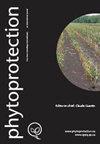Effect of temperature, rainfall and planting date on aflatoxin and fumonisin contamination in commercial Bt and non-Bt corn hybrids in Arkansas
IF 0.2
4区 农林科学
Q4 PLANT SCIENCES
引用次数: 73
Abstract
Corn (maize, Zea mays) is susceptible to contamination with aflatoxins, fumonisins and other mycotoxins, particularly in the southeastern USA. In principle, mycotoxin contamination could be reduced in commercial corn hybrids with shorter growing seasons by planting at dates which minimize plant stress during the critical kernel-filling period. To evaluate this strategy, commercial Bt and non-Bt hybrids were planted in Arkansas in mid-April and early May of 2002, 2004 and 2005. The mid-April planting date resulted in lower aflatoxin contamination in harvested corn each yr and in significantly less frequent contamination above a regulatory action level in 2005 and overall than did the early-May planting date in both Bt and non-Bt corn. The mid-April planting date resulted in significantly lower total fumonisin contamination in harvested corn and in less frequent contamination above a regulatory advisory level than the early May planting date in 2 of 3 yr and overall in both Bt and non-Bt corn. All fumonisin subtypes studied were reduced. Frequent co-occurrence of aflatoxin and fumonisin was observed. Fumonisin levels averaged lower in Bt hybrids than in non-Bt hybrids at all plantings. Reduced aflatoxin and fumonisin contamination with mid-April planting could not be explained by any measure of heat stress during the kernel-filling period.温度、降雨和播种日期对阿肯色州商业Bt和非Bt玉米杂交品种黄曲霉毒素和伏马毒素污染的影响
玉米(maize, Zea mays)容易受到黄曲霉毒素、伏马菌毒素和其他真菌毒素的污染,特别是在美国东南部。原则上,在生长季节较短的商品玉米杂交种中,通过在关键的灌浆期将植株胁迫降到最低的日期播种,可以减少霉菌毒素污染。为了评估这一策略,我们于2002年、2004年和2005年的4月中旬和5月初在阿肯色州种植了商业Bt和非Bt杂交作物。在每年收获的玉米中,4月中旬播种的黄曲霉毒素污染较低,而且在2005年和总体上,比5月初播种的Bt和非Bt玉米污染频率明显低于监管行动水平。与5月初播种相比,4月中旬播种的收获玉米的伏马菌素总污染显著降低,超过监管建议水平的污染频率也较低,在3年中的2年和总体上,Bt和非Bt玉米都是如此。所有研究的伏马菌素亚型都减少了。黄曲霉毒素和伏马菌素经常同时出现。在所有种植中,Bt杂交种的伏马菌素水平平均低于非Bt杂交种。4月中旬播种时黄曲霉毒素和伏马毒素污染的减少不能用灌浆期的任何热胁迫措施来解释。
本文章由计算机程序翻译,如有差异,请以英文原文为准。
求助全文
约1分钟内获得全文
求助全文

 求助内容:
求助内容: 应助结果提醒方式:
应助结果提醒方式:


